Fantasy Football ADP Battle: Amon-Ra St. Brown vs. Malik Nabers

By
- Malik Nabers is primed for another target-filled season: The Giants will feed Nabers once again this season, which is bound to lead to significant fantasy production as he enters Year 2.
- Amon-Ra St. Brown has been a picture of high-end consistency: St. Brown’s talent and offensive situation have led to back-to-back PPR WR3 seasons, and he should be in for another big year in 2025.
- Subscribe to PFF+: Get access to player grades, PFF Premium Stats, fantasy football rankings, all of the PFF fantasy draft research tools and more!

This fantasy football article series breaks down the toughest draft-day decisions facing fantasy managers, using Underdog’s average draft position (ADP) as a guide. Each installment compares similarly ranked players at the same position, using key stats from previous seasons and contextual factors — including team situation — to identify the better pick.
Today’s matchup features New York Giants wide receiver Malik Nabers and Detroit Lions wide receiver Amon-Ra St. Brown, two players going near the end of the first round in fantasy drafts. Which one offers the better value? Let’s break it down.
MALIK NABERS (WR5) vs. AMON-RA ST. BROWN (WR6)

Nabers burst onto the scene in his rookie year, serving as the focal point of a Giants offense that leaned heavily on him from the start. He finished second in the NFL with 165 targets across just 15 games and led all rookie wide receivers with an 87.1 receiving grade in 2024. Nabers recorded five top-10 weekly finishes and ended the season as the PPR WR6.
In contrast, St. Brown operated in a more balanced Lions passing attack that didn’t rely on him as singularly, thanks to a deeper supporting cast. Still, he remained a central figure, ranking top-10 in targets (138) and top-five in receiving yards (1,263). He posted six top-10 weekly finishes, including two weeks as the overall PPR WR1.
INVOLVEMENT IN THE OFFENSE
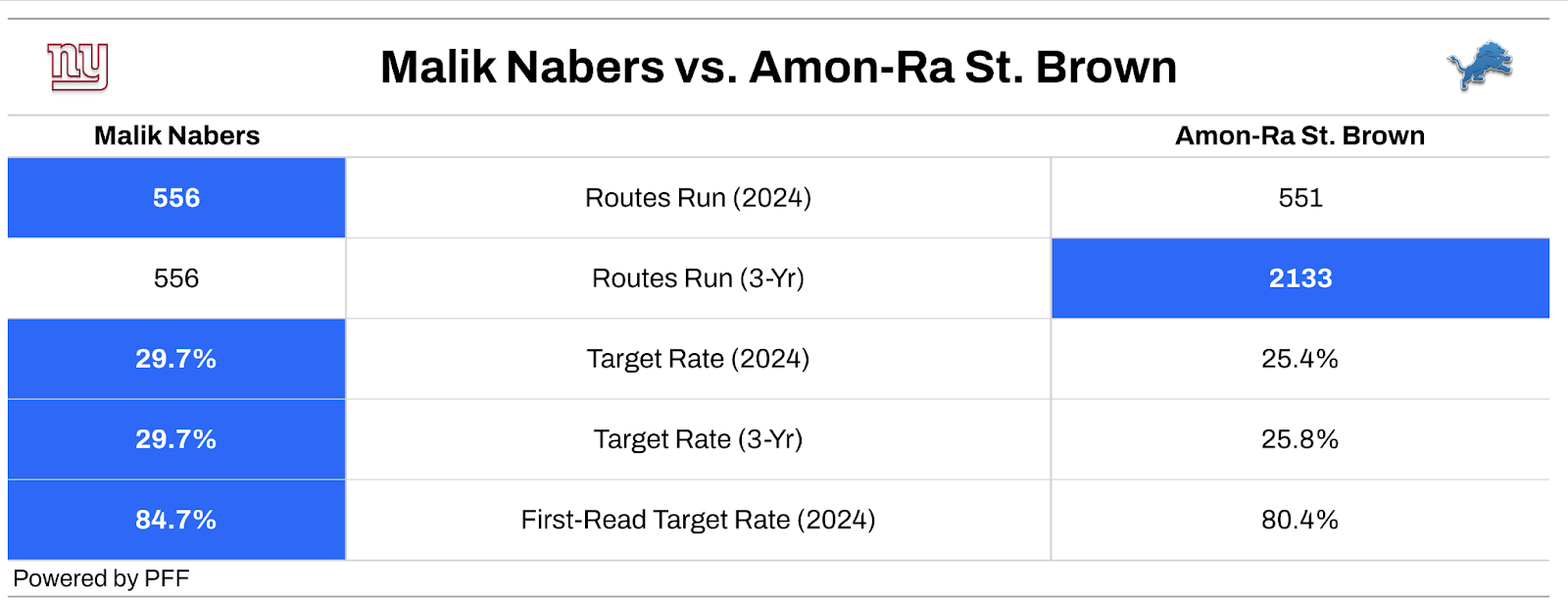
Nabers ranked second among 130 qualifying wide receivers in target rate, trailing only Puka Nacua (37.0%). His usage as a primary read was equally notable, as he finished second in the NFL with 133 first-read targets. He also led the league with 11.0 targets per game as a rookie. Given New York’s quiet offseason in terms of pass-catching additions, Nabers is poised to remain one of the league’s most heavily targeted players in 2025.
St. Brown, on the other hand, has thrived in a stable and efficient Detroit offense, producing back-to-back WR3 finishes in PPR formats and four straight top-eight seasons overall. The Lions haven’t had to funnel targets to him the way the Giants do with Nabers, which may cap his overall volume. Still, St. Brown consistently capitalizes on his opportunities and remains one of the most efficient high-usage wide receivers in the league.
PRODUCTION AND PERFORMANCE
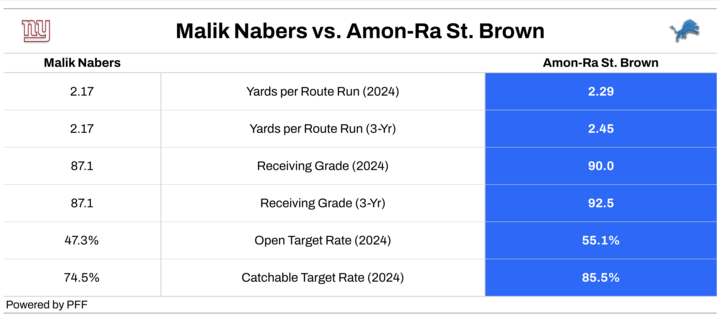
St. Brown’s experience, talent, and fit within Detroit’s offense have allowed him to flourish as one of the league’s top wide receivers. Coming out of 2024, he outperformed Nabers in several key categories — a result to be expected when comparing an established star to a rookie. Still, Nabers appears poised to close that gap quickly, as his rookie-year metrics already place him in elite company.
Efficiency remains a major strength for St. Brown. He ranked 12th in yards per route run and finished top-five in PFF receiving grade. While he may not consistently outpace Nabers in weekly target volume, he benefits from operating in a well-rounded offense that prevents defenses from locking in on him. That advantage should continue to create space and opportunities for St. Brown to produce WR1-level numbers.
HIGH-VALUE TARGET INVOLVEMENT
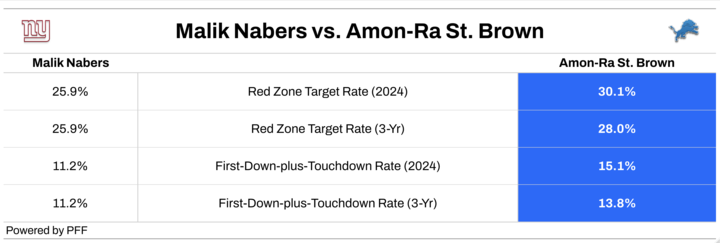
St. Brown holds another edge over Nabers when it comes to high-value scoring opportunities. The Lions led the league with 227 offensive snaps in the red zone last season, while the Giants ranked 31st with just 121. As a result, St. Brown ran 103 red-zone routes — nearly double Nabers’ 54 — and turned those into 31 targets, 24 receptions, and nine touchdowns.
Nabers was a clear red-zone focal point for the Giants, but the offense’s overall inefficiency limited his opportunities. That dynamic may not shift dramatically in 2025, though the addition of Russell Wilson brings some hope. Wilson helped the Steelers generate 115 red-zone plays (tied for seventh) after taking over as starter. If he can elevate the Giants’ scoring chances, Nabers stands to benefit most and could easily build on his 14 red-zone targets, six catches, and three touchdowns from last season.
TEAM PASSING AND QUARTERBACK SITUATION
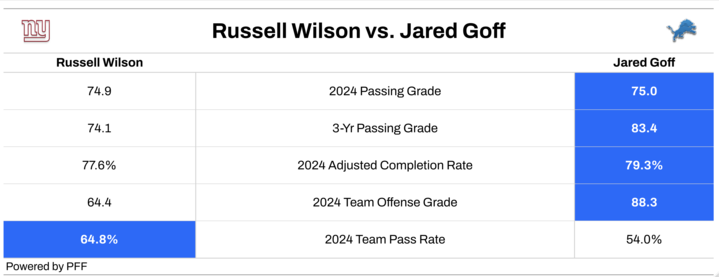
Russell Wilson is no longer the quarterback he once was, as reflected by his 74.1 passing grade over the past three seasons — ranking just 21st out of 28 qualifying quarterbacks. In contrast, Jared Goff has earned a top-10 passing grade since 2022, leading a Lions offense that consistently performed at a higher level despite a conservative approach. Detroit ranked 29th in pass rate last season, a factor that could limit St. Brown’s ceiling, especially with the team unlikely to deviate much from Dan Campbell’s established offensive philosophy.
Wilson enters 2025 in a completely new environment under head coach Brian Daboll, whose offenses have ranked top-10 in pass rate each of the past two seasons. While some of that volume is tied to the Giants often playing from behind, it’s fair to expect another pass-heavy approach — even if the team doesn’t take a massive leap forward.
That projected volume is a key edge for Nabers. He may not have the quarterback advantage, but few players in the league are likely to see more total targets. If Wilson can deliver the ball more accurately than Nabers experienced in 2024, that alone could give the second-year wideout the edge over St. Brown in fantasy value for 2025.
POTENTIAL 2025 TARGET COMPETITION
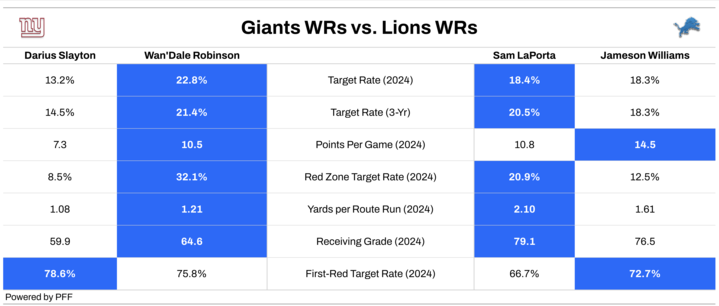
Wan’Dale Robinson stood out in target rate last season, largely due to his quarterback-friendly role as a low average depth of target (ADoT) and screen-game option. He totaled 132 targets (14th among wide receivers) while operating with the third-lowest ADoT at the position (5.1 yards). Robinson will remain a key part of the offense, but his role is distinct from Nabers’ and shouldn’t be viewed as a threat to Nabers’ volume or upside in 2025. Robinson finished as the PPR WR37, while Nabers, despite missing two games, ended the year as the WR6.
St. Brown faces stiffer competition for targets. Sam LaPorta emerged as one of the most heavily targeted tight ends in the league, especially in the red zone, where he ranked top-five at the position with 18 targets. Both LaPorta (nine) and Jameson Williams (14) saw more deep targets (20-plus yards) than St. Brown (seven) in 2024, slightly capping his access to high-value opportunities. By comparison, Nabers saw 29 such targets — more than double that of any Lions pass-catcher.
Still, St. Brown’s elite production stands out. Despite the competition, he finished as the WR3 in PPR formats last season, while Williams finished as the WR23 and LaPorta as the TE7. That level of output underscores St. Brown’s ability to thrive even in a crowded offense.


